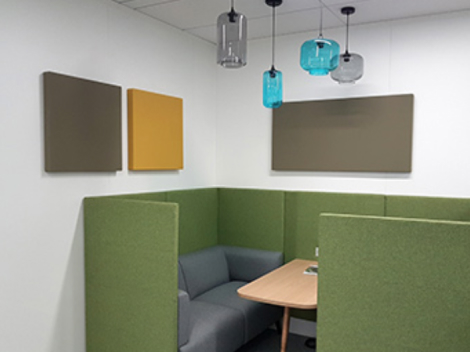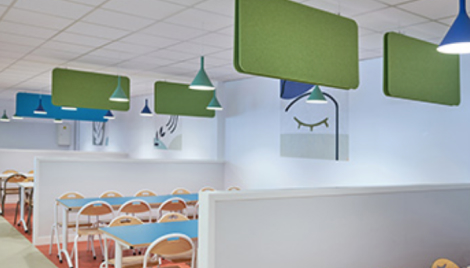Conversations, everyday noises (telephones ringing, footsteps, moving furniture), humming of equipment (printers, air conditioning units) or sounds coming from outside (cars, construction work) create noise pollution in working environments. Many businesses experience acoustic problems, in particular confidentiality or reverberation issues. Acoustic treatment and the design of the work areas are necessary in order to improve intelligibility concentration and productivity whilst limiting stress and tiredness. Good noise management improves the commitment and performance of employees.
Felt Vibe® offers a wide range of solutions for all these needs : on ceilings, walls or as dividers to meet all the requirements in the layout of buildings.
Open-plan workspaces

In open-plan offices, it is difficult to treat the wall surfaces as they are few and far from the users. Therefore, installing suspended acoustic panels above the workstations or acoustic totems are the most effective solutions in this type of situation.

In open-plan offices, it is difficult to treat the wall surfaces as they are few and far from the users. Therefore, installing suspended acoustic panels above the workstations or acoustic totems are the most effective solutions in this type of situation.
Hospitality
Customer satisfaction for a hotel depends on the quality of the service and the comfort of the establishment. This last criterion does not only concern the layout of the bedrooms but also the communal areas, restaurants, lobbies, meeting areas which must all guarantee good acoustic comfort. As a hotel is exposed to several types of noise, there a variety of solution to reduce them, including acoustic correction.
Noise annoying and sometime unbearable, it affects both mood and health. Hotels are no exception to this criticism. When a hotel does not provide good acoustic comfort, it can have an impact on the quality of sleep of the guests. There are many areas that cause noise pollution.
Restaurants
Customer satisfaction for a hotel depends on the quality of the service and the comfort of the establishment. This last criterion does not only concern the layout of the bedrooms but also the communal areas, restaurants, lobbies, meeting areas which must all guarantee good acoustic comfort. As a hotel is exposed to several types of noise, there a variety of solution to reduce them, including acoustic correction.
Noise annoying and sometime unbearable, it affects both mood and health. Hotels are no exception to this criticism. When a hotel does not provide good acoustic comfort, it can have an impact on the quality of sleep of the guests. There are many areas that cause noise pollution.

Communal Areas

In order to respect the regulations concerning the width of communal areas and especially corridors, acoustic wall panels are not ideal, acoustic correction using wallcoverings remain the best solution. In general a carpet is laid on the floor to limit the noise from footsteps and traffic. Even if this absorbs it a little, to guarantee acoustic comfort and to respect the acoustic regulations, but most importantly to avoid floating echoes between 2 opposing walls, it is necessary to treat the wall surfaces with decoration and hard-wearing acoustic wallcovering. For large communal areas such as lobbies with highly reverberant surfaces (no carpet or acoustic tiles) suspended acoustic panels are an essential addition to wallcoverings.
Co-working or seminar areas
Like meeting rooms, in addition to acoustic absorption problems, wear caused by customer traffic creates premature wear on the wall surfaces. It is therefore recommended to improve the room’s acoustics with acoustic wallcoverings but also above the work tables by means of suspended panels to be in proximity to the users. For large spaces it is also possible to treat the walls using acoustic panels.

Education

Educational buildings and all other public buildings must be built and equipped in such a way as to limit noise inside the buildings, by means of acoustic insulation with regards to the exterior and between rooms, to obtain good acoustic conditions, in addition to limiting the noise created by the buildings’ equipment.

Classrooms
It is essential to treat the ceiling using acoustic panels,
and several options are possible. In addition acoustic wallpanels can also be used to improve intelligibility. In amphitheatres with large walls surfaces, wall protection
by means of a hardwearing acoustic wallcovering is also a good additional absorbent, particularly for high frequencies.
Noises from equipment (kitchens, cutlery) and conversations that are responsible for the acoustic comfort.. Acoustic wallcoverings will correct high frequencies but will also limit the premature wear and tear on the walls and decorate
the space. They should be combined with acoustic panels to treat closer to the sound source and correct the medium and low frequencies of conversations.